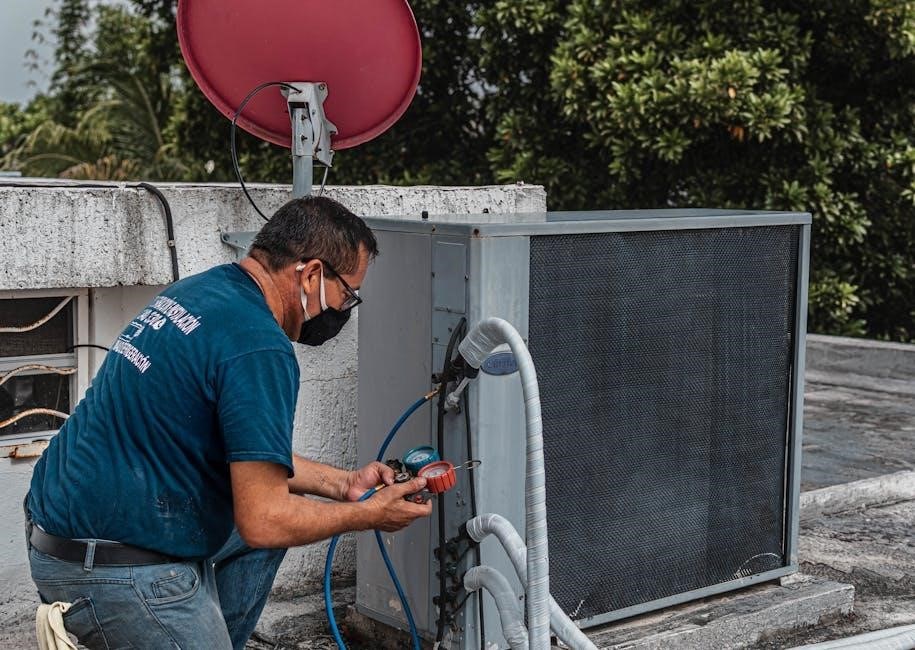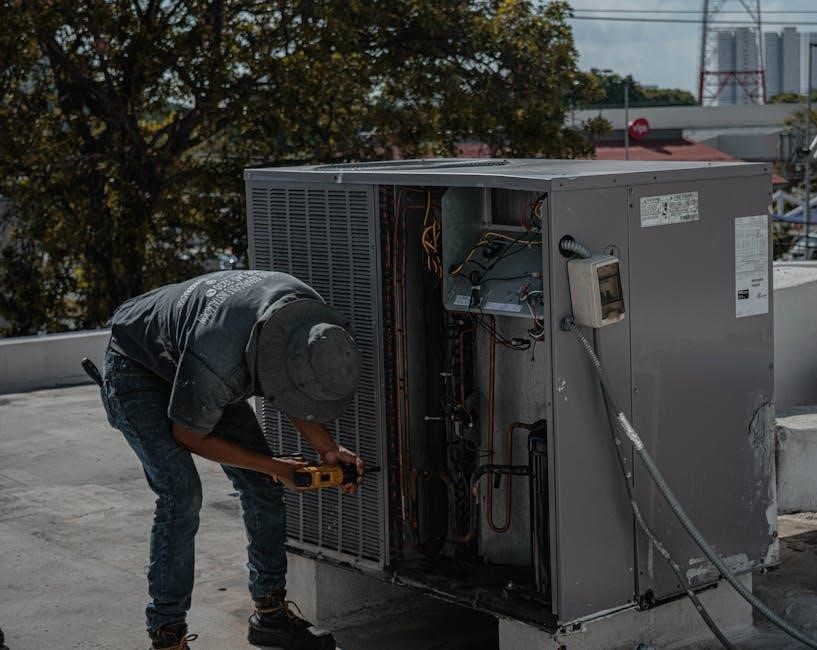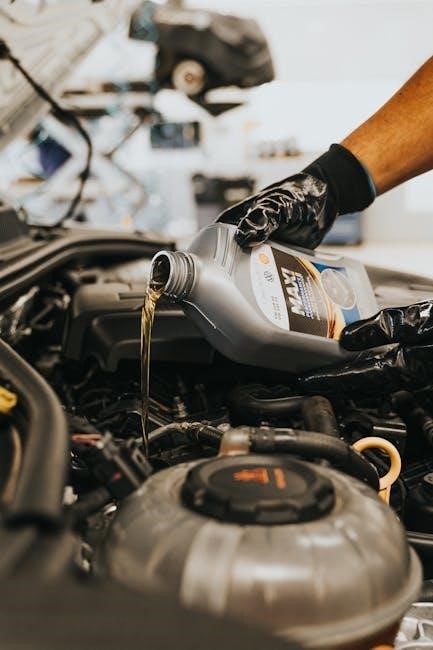Essential Tools for HVAC Technicians
Essential tools for HVAC technicians include multimeters‚ thermometers‚ and wrenches for system diagnostics and repairs. Power tools like drills and saws are also crucial for installations. Diagnostic tools such as manometers and leak detectors ensure precise system testing. These tools are often available through services offering same-day delivery.
1.1. Hand Tools
Hand tools are fundamental for HVAC technicians‚ enabling precise adjustments and repairs. Essential items include screwdrivers‚ pliers‚ wrenches‚ and hammers. Screwdrivers (flathead and Phillips) are used for disassembling units‚ while pliers assist with gripping and bending wires or pipes. Adjustable wrenches and pipe wrenches are crucial for tightening and loosening fittings. Utility knives and wire strippers are also indispensable for handling insulation and electrical connections. Many technicians rely on multitools for versatility in tight spaces. These tools are often stored in organized cases or tool belts for easy access. Additionally‚ torque wrenches ensure proper tightening of bolts and screws‚ preventing system leaks or damage. High-quality hand tools are a cornerstone of an HVAC technician’s workflow‚ allowing for efficient and safe system maintenance. With advancements in tool design‚ ergonomic options are now available to reduce fatigue during long workdays. Access to these tools is often facilitated through suppliers offering same-day delivery‚ ensuring technicians can maintain productivity without delays.
1.2. Power Tools
Power tools are essential for HVAC technicians to handle tasks requiring precision and efficiency at scale. Drills with various bits are used for making holes in ductwork and equipment casings. Impact wrenches and cordless drills simplify bolt and screw driving‚ especially in tight spaces. Circular saws and reciprocating saws are invaluable for cutting ducts‚ pipes‚ and panels. Sanders and grinders help in smoothing surfaces for better sealing. Additionally‚ rotary hammers are used for heavy-duty drilling in masonry or thick materials. Many power tools are cordless‚ offering greater portability and convenience on job sites. High-torque options ensure that even the toughest fasteners can be managed effortlessly. These tools often come with interchangeable batteries‚ reducing downtime. With same-day delivery services‚ technicians can quickly replenish their power tool inventory‚ ensuring uninterrupted workflow. Regular maintenance of power tools‚ such as cleaning and charging batteries‚ is crucial for longevity and performance. By investing in durable power tools‚ HVAC technicians can streamline their processes and deliver high-quality results efficiently. This equipment is a vital component of a technician’s arsenal‚ enabling them to tackle demanding tasks with ease and precision.

Specialized Tools for HVAC Systems
Specialized tools for HVAC systems include ductwork tools like crimpers and seamers‚ and refrigeration tools such as vacuum pumps and manifold gauges. These tools are designed for precise system installations‚ repairs‚ and maintenance‚ ensuring optimal performance and efficiency. Same-day delivery services often provide quick access to these essentials.
2.1. Ductwork Tools
Ductwork tools are essential for HVAC technicians‚ enabling precise installations and repairs. Key tools include duct crimpers for securing joints‚ duct seamers for forming connections‚ and duct punches for creating holes. These tools ensure proper airflow and system efficiency. Additionally‚ technicians often use duct knives‚ snips‚ and saws for cutting and shaping duct materials. Many professionals rely on services like Parts Town for same-day delivery of these tools‚ ensuring quick access to maintain workflow. Properly organized tool storage solutions‚ such as cases or work van setups‚ help technicians stay efficient on-site. Ductwork tools are critical for maintaining HVAC system performance and longevity.
2.2. Refrigeration Tools
Refrigeration tools are vital for HVAC technicians working with cooling systems. Essential tools include manifold gauges for measuring refrigerant pressure‚ vacuum pumps for evacuating systems‚ and tube cutters and benders for handling copper tubing. Leak detection tools‚ such as electronic leak detectors and UV dye kits‚ are also critical for identifying refrigerant leaks. Recovery machines are necessary for safely handling refrigerants during system repairs or replacements. Additionally‚ technicians often use refrigerant scales for accurate charging and thermometers for monitoring system temperatures. These tools are typically sourced from suppliers like Parts Town‚ which offers same-day delivery to ensure technicians can maintain workflow. Proper organization of these tools in toolboxes or work vans is essential for efficiency. Refrigeration tools are specialized and require regular maintenance to ensure accuracy and reliability in HVAC operations.

Diagnostic and Testing Tools
Diagnostic tools like multimeters and thermometers help HVAC technicians identify system issues. Pressure testing kits and airflow meters ensure proper system performance. These tools‚ available with same-day delivery‚ enable efficient troubleshooting and maintenance‚ ensuring optimal HVAC system operation and energy efficiency.
3.1. Pressure Testing Tools

Pressure testing tools are vital for HVAC technicians to ensure system integrity and diagnose leaks. These tools include pressure gauges‚ test kits‚ and vacuum pumps. They help measure refrigerant pressure‚ detect leaks‚ and verify system performance. Accessories like hoses and adapters are also essential for precise testing.
Using these tools‚ technicians can identify issues in refrigeration and ductwork systems. Regular pressure testing ensures energy efficiency and prevents system failures. With advancements in technology‚ digital pressure testers now offer accurate readings‚ enhancing diagnostic capabilities. These tools are often available through suppliers offering same-day delivery‚ ensuring quick access for technicians.
Proper use of pressure testing tools requires training to interpret readings and perform accurate diagnoses. They are indispensable for maintaining HVAC systems‚ ensuring safety‚ and optimizing performance. Technicians rely on these tools to resolve issues efficiently‚ making them a cornerstone of HVAC maintenance and repair workflows.
3.2. Airflow Measurement Tools
Airflow measurement tools are essential for HVAC technicians to ensure proper system performance and balance. These tools include anemometers‚ pitot tubes‚ and flow hoods. Anemometers measure air velocity‚ while pitot tubes assess pressure differences to calculate airflow rates. Flow hoods are used to measure airflow through grilles and vents.
These tools help technicians identify airflow imbalances‚ leaks‚ or blockages in ductwork. By ensuring accurate airflow measurements‚ technicians can optimize system efficiency and comfort. Accessories like thermometers and pressure sensors often complement these tools to provide comprehensive system analysis.
Modern airflow measurement tools offer digital readings for precision and ease of use. They are critical for commissioning new systems and troubleshooting existing ones. With advancements in technology‚ these tools now integrate with smartphone apps for data logging and analysis‚ enhancing diagnostic capabilities.
Technicians rely on airflow measurement tools to maintain indoor air quality and ensure proper ventilation. Their use is fundamental for resolving issues related to heating‚ cooling‚ and airflow distribution in HVAC systems. Availability through suppliers like Parts Town ensures quick access to these essential tools.

Safety Equipment and PPE
Safety equipment and PPE are vital for HVAC technicians to protect against hazards. Essential items include hard hats‚ safety glasses‚ gloves‚ and steel-toe boots. These tools ensure protection from physical injuries during installations‚ repairs‚ and system maintenance.
Fall protection gear‚ like harnesses and lanyards‚ is critical for technicians working at heights. Safety nets and rope access equipment also prevent accidents. Proper PPE ensures compliance with safety regulations and minimizes workplace risks‚ safeguarding both technicians and clients.

4.1. Personal Protective Equipment
Personal Protective Equipment (PPE) is essential for HVAC technicians to ensure safety while working with electrical systems‚ sharp objects‚ and hazardous materials. Hard hats protect against falling debris‚ while safety glasses and goggles shield eyes from chemicals and particles. Heat-resistant gloves prevent burns when handling hot equipment‚ and steel-toe boots safeguard feet from heavy tools or objects. High-visibility vests enhance visibility in low-light environments‚ reducing accidental injuries.
Respirators and dust masks are crucial when working with insulation or in dusty environments to prevent inhalation of harmful particles. Earplugs protect hearing in loud settings‚ such as near compressors or fans. Properly fitted PPE ensures comfort and effectiveness‚ while adherence to safety standards minimizes workplace risks. Regular inspection and maintenance of PPE are vital to uphold their protective qualities. These items are often sourced from reliable suppliers‚ ensuring quality and compliance with industry regulations.
Availability through services like Parts Town‚ offering same-day delivery‚ ensures technicians can access these essentials quickly‚ maintaining productivity without compromising safety. This emphasis on PPE underscores its critical role in protecting technicians and enabling them to perform their duties effectively.
4.2. Fall Protection Gear
Fall protection gear is indispensable for HVAC technicians working at heights‚ such as on rooftops or ladders. Harnesses‚ lanyards‚ and anchor points are key components that prevent falls and minimize injury risk. Self-retracting lanyards automatically adjust length‚ ensuring safety in dynamic environments.
Hard hats and safety helmets with chin straps protect the head from impact during falls or falling objects. Rope grabs and shock-absorbing lanyards reduce the force of a fall‚ while anchor points provide secure attachment to stable structures. Safety nets and guardrails are also used to create barriers around work areas.
Regular inspection of fall protection equipment is critical to ensure reliability. Proper training on gear usage and safety protocols is essential for technicians. Suppliers like Parts Town offer quick access to these tools‚ enabling technicians to maintain safety without delays. Fall protection gear is vital for preventing accidents and ensuring compliance with safety regulations in the HVAC industry.

Tool Organization and Storage Solutions
Toolboxes‚ portable cases‚ and work van organization systems are essential for HVAC technicians. Adjustable compartments and labels enhance efficiency. Durable storage solutions protect tools and ensure easy access. Parts Town offers these tools‚ enabling technicians to maintain order and productivity on the go.
5.1. Toolboxes and Cases
Toolboxes and cases are indispensable for HVAC technicians‚ providing organized storage and protection for tools. They come in various sizes‚ from portable cases to large‚ durable boxes. Features like customizable compartments and secure latches ensure tools remain accessible and damage-free. High-quality materials‚ such as heavy-duty plastics or metals‚ offer longevity. Technicians can choose between stationary or mobile options‚ depending on their needs. Additionally‚ many toolboxes are designed with ergonomic handles for easy transport. Parts Town offers these essential tools‚ ensuring technicians can maintain order and efficiency; With same-day delivery‚ same-day shipping‚ or local pickup options‚ staying equipped has never been easier. Proper tool organization not only saves time but also extends the life of tools‚ making toolboxes and cases a vital investment for any HVAC professional.
5.2. Work Van Organization
Work van organization is critical for HVAC technicians to maximize efficiency and ensure tools are readily accessible. Shelving units‚ storage bins‚ and drawer systems are popular solutions for maintaining order. These systems help protect equipment‚ reduce clutter‚ and prevent tools from shifting during transit. Many technicians opt for customizable setups‚ including adjustable shelves and modular compartments‚ to tailor their van layout to specific needs. Labeling each storage area enhances visibility‚ saving time during emergencies. Additionally‚ securing heavier tools with straps or brackets prevents damage and ensures safety while driving. A well-organized work van not only improves workflow but also projects professionalism. Parts Town‚ with its same-day delivery and industry-leading inventory‚ offers essential tools and storage solutions‚ making it easier for technicians to maintain a tidy and functional workspace on the go. Proper van organization is an investment in efficiency‚ safety‚ and job satisfaction.

Digital and Smart Tools for Modern HVAC
Digital tools like smartphone apps and smart sensors enhance HVAC diagnostics and system monitoring. IoT devices enable real-time data collection‚ improving energy efficiency and remote troubleshooting. These technologies‚ supported by resources like Parts Town‚ streamline operations for modern technicians.
6.1. Smartphone Apps for HVAC

Smartphone apps have revolutionized HVAC operations‚ enabling technicians to access critical tools and data on the go. These apps offer features like temperature monitoring‚ system diagnostics‚ and remote control of HVAC units. They also provide real-time weather updates‚ helping technicians anticipate system loads and optimize performance.
Some apps include calculators for duct sizing‚ load calculations‚ and refrigerant charging‚ streamlining complex tasks. Diagnostic tools within these apps can identify system malfunctions and guide technicians through repairs. Additionally‚ apps like those offered by Parts Town integrate with inventory systems‚ allowing technicians to order parts seamlessly and access technical manuals.

These digital solutions enhance efficiency‚ reduce errors‚ and improve customer satisfaction. With apps‚ technicians can document service calls‚ generate reports‚ and share results with clients instantly. This integration of mobile technology into HVAC workflows ensures faster problem-solving and better overall system management.
6.2. Smart Sensors and IoT Devices
Smart sensors and IoT devices are transforming HVAC system monitoring and maintenance. These advanced tools provide real-time data on temperature‚ humidity‚ and airflow‚ enabling precise system control. IoT-enabled sensors can detect anomalies‚ predict potential failures‚ and optimize energy consumption.
Technicians can integrate these devices with building management systems (BMS) to automate responses to system changes. For instance‚ smart thermostats adjust settings based on occupancy and external conditions. IoT devices also facilitate remote monitoring‚ allowing technicians to troubleshoot issues without on-site visits.
Moreover‚ smart sensors can track equipment performance and send alerts for maintenance needs‚ reducing downtime. Integration with inventory systems‚ like those from Parts Town‚ ensures seamless access to replacement parts. These technologies enhance efficiency‚ reduce energy costs‚ and improve overall system reliability.